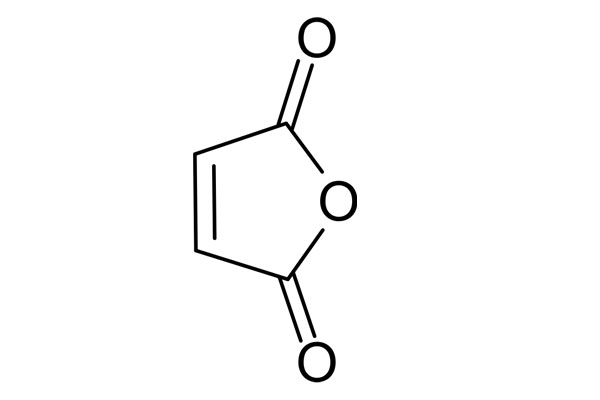Cas No: 108-31-6
EINESC No: 203-571-6
Molecular weight: 98.057 g/mol
Chemical Formula: C4H2O3
Chemical Structure:
Physical Properties
General Properties: white crystals
Odor: extremely disturbing
Intensity: 1.48 g/cm3
Boiling point: 202 °C
Melting point: 52,8 °C
Flash point: 102 ° C
Vapor pressure: –
Refraction index:-
Solubility (aqueous) reactive

General Properties
Maleic Anhydride is a colorless liquid that has a stong odor. It is the waterless form of maleic acid. It is commonly used in polymer coating production. Thanks to its duel functional groups, it can go into many chemical reactions and therefore, it is produced in high amounts worldwide.
Production
Maleic anhydride had been produced by oxidation of benzene and aromatic combinations. In today’s chemistry, it is produced from vapor phase oxidation of butane. Benzene usage is abandoned due to its cost and incoming emission legislations.
Applications
Maleic anhydride is mostly used for unsaturated polyester resin production. It is pioneer in production of thermoplastic plyurethane, elastane fibre, polybutane terephthalate and many other chemicals.
It is used as curing agent in epoxy resin production. It works as corrosion blocker for internal combustion engine oils.
It is also used in alkid resin, sweetener, water conditioning chemical and agricultural chemical production.
Maleic anhydride is also used in pesticide production. It is a byproduct in 1,4-BDO and THF production. It is also used in synthetic sweetener, food concentrator, paper processing, water purification, epoxy hardener, hair spray, pharmaceutic, agriculture chemical and copolymer production.
Safety Measures and Toxic Values
Maleic anhydride is toxic for humans. It is extremely irritant for eyes and skin. If inhaled, it may cause chronic asthma and pulmonary edema. It may also cause serious allergic problems.